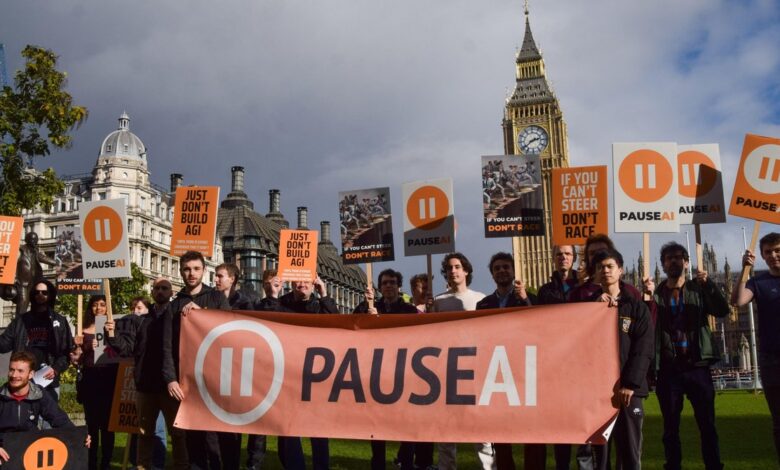Protesters are fighting to stop AI, but they are divided over how to do it

One Discord member questioned whether it would be too disruptive if protesters staged sit-ins or chained themselves to the doors of AI developers. “Probably not. In the end, we do what we have to do for a future with humanity, while we still can.”
Meindertsma was worried about the consequences of AI after reading super intelligencea 2014 book by the philosopher Nick Bostrom that popularized the idea that highly advanced AI systems could endanger human existence. Joseph Miller, the organizer of the PauseAI protest in London, was similarly inspired.
It was the launch of OpenAI’s large language model Chat-GPT 3 in 2020 that really made Miller worried about the trajectory AI was on. “It occurred to me that this is not a problem in the distant future, this is something that AI is actually getting better at now,” he said. Miller joined an AI safety research nonprofit and later joined PauseAI.
Bostrom’s ideas have been influential in the “effective altruism” community, a broad social movement that includes advocates of long-termism: the idea that influencing the long-term future should be moral priorities of people today. Although many of PauseAI’s organizers have roots in the effective altruism movement, they aspire to reach beyond philosophy and attract more support for their cause.
Pause AI US director Holly Elmore wants the movement to become a “broad church” that includes artists, writers and copyright owners whose livelihoods are at risk due to possible AI systems. imitate creative works. “I am a pragmatic person. Ultimately, I was thinking about the consequences, but the real injustice that motivated me to do this type of activism was the lack of consent” from the companies that produced the AI models, she said.
“We don’t have to choose which harms of AI are most important when we talk about moratorium as a solution. A moratorium is the only solution that solves all those problems.”
Miller echoed this sentiment. He said he has spoken to artists whose livelihoods have been affected by the rise of AI art producers. “These are real problems today and are signs of much more dangerous things to come.”
One of the protesters in London, Gideon Futerman, had a stack of leaflets that he was trying to hand out to civil servants leaving the building opposite. He has been protesting with the group since last year. “The idea of being able to pause has really taken root since then,” he said.
Futerman is optimistic that protest movements can influence the trajectory of new technologies. He points out that opposition to genetically modified organisms was instrumental in causing Europe to abandon the technology in the 1990s. The same is true of nuclear energy. Not that these movements necessarily have the right ideas, he said, but they demonstrate that popular protests can hinder the progress of even technologies that promise low-carbon energy or more bountiful crops.
In London, a group of protesters moved across the street to hand out leaflets to the stream of civil servants leaving government offices. Most appeared unconcerned, but a few took a piece of paper. Earlier that day, Rishi Sunak, the British prime minister who six months ago chaired the first AI Safety Summit, gave a speech in which he nodded to concerns about AI. But after that cursory consultation, his focus was firmly on the potential benefits.
Pause AI leaders WIRED spoke with said they are not currently considering more disruptive direct actions like sit-ins or encampments near AI offices. “Our tactics and methods are actually very moderate,” Elmore said. “I want to be a moderate base for many organizations in this field. I am sure that we will never tolerate violence. I also want Pause AI to go further than that and become very reliable.”
Meindertsma agreed, saying more disruptive action at this time was unreasonable. “I really hope that we don’t need to take further action. I don’t expect that we will need to do that. I don’t feel like I’m the type of person to lead a movement that’s not entirely legitimate.”
The founder of Pause AI also hopes that his movement can eliminate the “AI doomer” label. “A perishing person is one who abandons humanity,” he said. “I am an optimist; I believe we can do something about this.”




